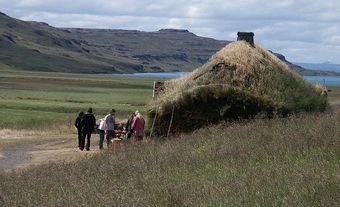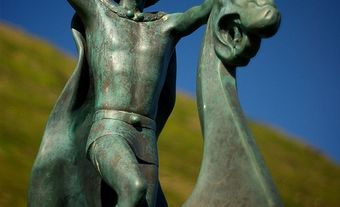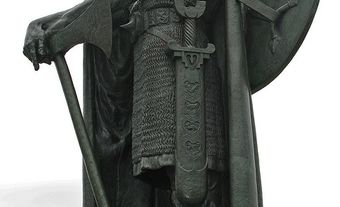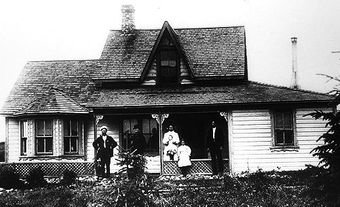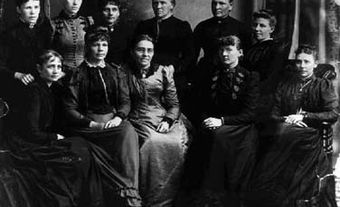Icelanders, coming by way of Greenland, were the first European visitors to what is now Canada. The 2016 Canadian census reported 101,795 people with Icelandic ethnic origins, and 1440 people whose mother tongue was Icelandic.

Explorer Eric The Red established a settlement in Greenland in about 985 AD, and in 986 Bjarni Herjolfsson made the first known sighting by Europeans of the northeast coast of Canada. Archaeological excavations at L'Anse Aux Meadows demonstrate that Norse settled in Newfoundland. Karlsefni's son Snorri was probably the first European born in what is now Canada.
History
Iceland, an island settled in the 9th century AD by renegade Norwegian chieftains and their followers, is warmed by the Gulf Stream and has a fairly moderate climate. Its uninhabitable interior is a volcanic mountain plateau of glaciers, lava fields and desert, but the treeless coast provides grazing land for sheep and cultivation. The Icelandic Althing (established 930 AD) is the oldest parliament in the world.
Through the centuries Icelanders suffered many natural calamities. By 1800 the national population was reduced to only 47 000 by disease, starvation and volcanic eruptions. In the 19th century, new disasters, including sheep epidemics, a deterioration in the climate and more volcanic eruptions, followed. The Danish government, which controlled Iceland at the time, offered to relocate the entire population to Denmark. The Icelanders declined, although small parties immigrated to Brazil and Wisconsin. The first Icelander to land on Canadian shores since his Norse ancestors was 22-year-old Sigtryggur Jonasson, who arrived in Quebec City on 12 September 1872.
Migration
In 1873 about 150 more Icelanders arrived in Quebec, encouraged by Jonasson. They were given free transportation to Ontario by the Canadian government, as well as offers of free land. Rosseau, in the Muskoka district, was selected as a site. However, government employment, which had been promised until the land was cleared, was not adequate, and most settlers soon left, leaving behind a small permanent settlement.
A second party arrived in 1874, settling in Kinmount, Ont. An immigration officer from Nova Scotia induced a large number to relocate at what the Icelanders called Markland, near Halifax, with offers of land, household appliances and financial aid. The land was not arable, however.
Settlement Patterns
In 1875, 235 Icelanders travelled north by flatboat on the Red River from Winnipeg, Manitoba, to the west shore of Lake Winnipeg. There they had been promised an Icelandic reserve in what was then an unorganized part of the Northwest Territories. This reserve, established by an order-in-council, became New Iceland, a unique political structure in Canadian history. In 1876, 1200 others joined the first group. Fifty immigrants had remained in Winnipeg the first year, and 200 the second, creating the basis for the first permanent urban Icelandic settlement in Canada.
In New Iceland the settlers created their own laws, maintained their own schools, and generally managed their own affairs. A series of natural disasters, including floods and a smallpox epidemic 1876-77, decimated the population, until in 1878 a general exodus to Winnipeg and North Dakota began. By 1881 the population of the New Iceland area had declined to about 250.
In 1881, as well, the provincial boundaries were extended north, and New Iceland became part of Manitoba, though remaining to this day, heavily Icelandic. The main settlement in New Iceland was Gimli. Other rural areas of Manitoba settled by Icelanders include Lundar (on Lake Manitoba); Glenboro, in the southwestern region of the province; Selkirk, north of Winnipeg; and Morden to the south.
Icelanders continued to immigrate to Winnipeg throughout the last 20 years of the 19th and 20th centuries. Later settlements were established in rural Saskatchewan and Alberta, but these were largely settled by families and individuals moving from Manitoba and from Icelandic settlements in the US. Descendants of Icelanders now live across Canada. Between 1978 and 1984, 105 Icelanders immigrated to Canada. In the 2016 Canadian census, 101,795 people reported Icelandic ethnic origins (8630 single responses and 93,165 multiple responses).
Economic Life
Most of the immigrants remained in farming, generally their profession at home. Agricultural settlement in Ontario and Nova Scotia proved unsuccessful and conditions in New Iceland were not much better. The freshwater fishery contributed to the economic viability of New Iceland.
The immigrants sent their children to universities whenever possible, which may have influenced the pattern of assimilation. Icelanders did not encounter much prejudice and there was a fairly high rate of intermarriage between Icelanders and the settled population. Typically, Icelanders entered the professions, particularly medicine, law and education.
Social Life and Community
From the time New Iceland was settled, Icelanders have preserved elements of traditional Icelandic society, culture and language. Factionalism, however, permeated almost all of the Icelanders' endeavours, and this is reflected in their many voluntary associations, most of which, in New Iceland, were organized around religious themes and topics.
The most important association historically, the Icelandic National League of North America, was founded in 1919 to assist Icelanders to adapt to Canada and to preserve elements of Icelandic heritage. Chapters of the league were established in almost every traditional Icelandic settlement and in the cities to which children of the immigrants had relocated. In 1942 the Icelandic Canadian Club began publishing the first English-language Icelandic publication in North America, the Icelandic Canadian magazine.
The Icelandic associations have traditionally hosted events for social and educational reasons, the most important being the Icelandic Festival (Islendingadagurinn), first held in Winnipeg in 1890, and now held annually since 1932 in Gimli on August 2. Originally, the purpose was to commemorate the granting of a constitution to Iceland in 1874, but in time it has also become an event to honour the Icelandic pioneers in Canada.
Religion and Cultural Life
The Lutheran Church (the state church in Iceland) has been the most prominent, and the Icelandic Evangelical Lutheran Synod of America held its first conference in Winnipeg in 1885. The Unitarian Church was the second-largest church among Icelanders, although it is not clear how this situation developed. The first Unitarian Church opened in 1892. Considerable political and theological rivalry existed between members of the two denominations in Winnipeg and this carried over into many of the smaller, rural communities. The United Church is now the second-largest denomination among Icelanders.
The first Icelandic newspaper in North America was Framfari (The Progress), published in New Iceland between 1877 and 1880. Between 1879 and 1910, eight other publications originated in Gimli. In 1886 the Icelandic newspaper Heimskringla (The World) was founded. Lögberg (The Tribune) was founded in 1887, partly in opposition to Heimskringla. Both were published in Icelandic. They were amalgamated in 1959 into Lögberg-Heimskringla, published in English ( see Newspapers in Canada.)
Literature dating the sagas and the settlement of Iceland is probably the most unifying theme in Icelandic culture. The Icelanders in Canada have produced many poets and novelists writing in both English and Icelandic. Stephán G.Stephansson is considered by many critics to be the foremost Icelandic poet of this century. Stephansson's contemporary, Guttormur J. Guttormsson, was born in New Iceland in 1878 and did not visit Iceland until 1939. He was best known, perhaps, for the poem Sandy Bar, a tribute to the Icelandic pioneers in New Iceland. Vilhjalmur Stefansson, the arctic explorer and anthropologist, wrote extensively on the Inuit. Contemporary Icelandic writers include the late Laura Goodman Salverson, winner of the Governor General's Literary Award and the first editor of the Icelandic Canadian magazine and author of The Viking Heart and Confessions of an Immigrant's Daughter, William Valgardson, author of Bloodflowers and other works, David Arnason, playwright and author of collections of poetry, short stories and a novel, and Kristjana Gunnars, author of several books of poetry.
Education
In Iceland literacy has long been a requirement for marriage and everyone was expected to have an intimate knowledge of the early sagas. In New Iceland a request was made for provision of a school even before homes had been built. In Winnipeg, Icelandic was first taught at Wesley College (now University of Winnipeg) in 1901. In that same year the Manitoba Department of Education approved the teaching of Icelandic in provincial schools (when requested by parents) and the University of Manitoba accepted it as a second language for incoming students. The Jon Bjarnson Academy, sponsored by the Lutheran Church, held secondary school classes in Winnipeg between 1913 and 1940. In 1951 the chair in Icelandic Language and Literature was established at the University of Manitoba. The Icelandic collection in the U of Man library now has a full-time curator and over 14 000 volumes. The 2016 census recorded 1440 people whose mother tongue (first language learned) was Icelandic.
Politics
Icelanders are not identifiable with any particular political ideology or Canadian political party, although many have distinguished themselves in political service. In 1898 Sigtryggur Jonasson was elected to the Manitoba legislature to represent St Andrews. Margaret J. Benedictsson, editor of the women's magazine Freyja from 1898 to 1910, formed the first women's suffrage society in Winnipeg in 1908. Thomas H. Johnson was appointed attorney general and minister of public works for Manitoba in 1915, becoming the first Icelandic Cabinet minister in Canada. Dr. George Johnson was Minister of Health for Manitoba befor lieutenant governor of the province in his later years.

 Share on Facebook
Share on Facebook Share on X
Share on X Share by Email
Share by Email Share on Google Classroom
Share on Google Classroom
